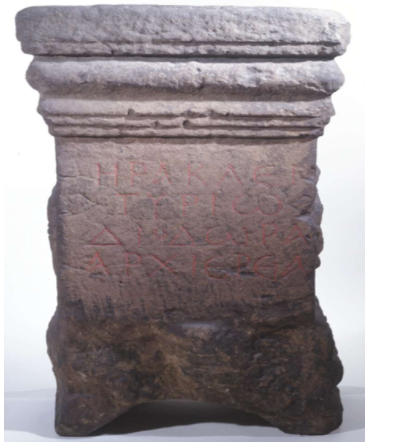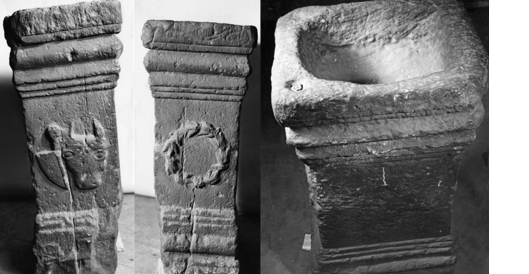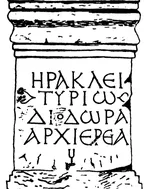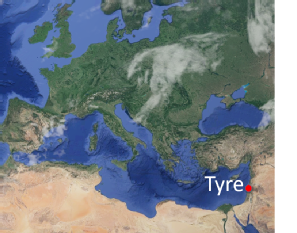Diodora the Priestess
An altar dedicated by Diodora

The altar is made of sandstone, which would have been quarried in Britain which is not as durable as marble and has some damage to it.
It was dedicated by Diodora, in the 3rd century AD, and was found in a churchyard at Corbridge, on Hadrian’s Wall in 1702. It was later donated to the British Museum, and if you visit you can see it in Gallery 49.
What was an altar used for?
Altars were important as they allowed people to communicate with the gods. They were often more symbolic rather than functional and not all altars would have been used for sacrifices. They often provided a focal point for rituals and offerings, which was a very important part of Roman religion.
Dedicating an altar was often a part of a reciprocal relationship between the dedicant and the deity. People would ask a deity for help or protection and would promise (via making a vow) to make a dedication (altars or other objects) to the deity in return for their assistance.
There are a large number of votive (an object dedicated to a deity) altars from Roman Britain and they are the dominant form of inscribed monuments. Adding an inscription allowed the public recording of the person’s relationship with the deity.
Different views of the altar

The image to the left shows three different views of the altar.
The detail on the far left shows a knife and bucranium (which is the head of an ox).The middle image shows a wreath. Each of these details are decorative motifs, and they refer to animal sacrifice, which of course was a central part of Graeco-Roman religion.
The image on the right shows the top of the altar which has been hollowed out suggesting that the altar could have been used later as a stoup to hold holy water. It also has a metal fitting on it so it may well also have had a lid.
The altar’s inscription

The inscription on the front of the altar is in Greek and reads:
ΗΡΑΚΛΕΙ
ΤΥΡΙΩ
ΔΙΟΔΩΡΑ
ΑΡΧΙΕΡΕΙΑ
This can be translated as: “To Heracles of Tyre, Diodora the high-priestess (set this up)”.
Greek inscriptions are unusual in Roman Britain, but it is not unique and there was another similar altar found nearby which also has a similar Greek inscription.
 The deity addressed is Herakles of Tyre. This is an example of a hero cult which was worshipped, and although these were often quite localised, some, such as Herakles, became more widespread and incorporated into the main Roman pantheon of deities. Herakles is the Greek name for the hero known as Hercules in Roman mythology and religion. Heracles is also understood as the Greek name for the Phoenician god Melqart, the patron deity of the city of Tyre.
The deity addressed is Herakles of Tyre. This is an example of a hero cult which was worshipped, and although these were often quite localised, some, such as Herakles, became more widespread and incorporated into the main Roman pantheon of deities. Herakles is the Greek name for the hero known as Hercules in Roman mythology and religion. Heracles is also understood as the Greek name for the Phoenician god Melqart, the patron deity of the city of Tyre.
So this means that this altar provides a good example of the fluidity and multiculturalism of Roman religion and indeed in Roman Britain: Herakles was originally a Greek hero, adopted into the Roman pantheon, conflated with an Eastern deity, and then transported to the remote provincial garrison of Corbridge at Hadrian’s Wall.
Who was Diodora?
Unfortunately, we know nothing about her other than what is on the inscription, but this does tell us a few things:
Firstly, she identifies herself as ARCHIEREIA which is translated as “priestess” or perhaps “high priestess”. This word has associations with the male religious offices of the asiarchs in Asia, so it shows another element of eastern religious culture being brought into Roman Britain.
We can’t know what rituals or activities Diodora would have undertaken, but we do know that the role of a priestess in Roman society was the only civic one which women were allowed to hold. There were also many events and festivals in the religious calendar which were related to cults specifically associated with women, such as the Bona Dea and the Matronalia.
Diodora’s dedication might reflect her desire for spiritual familiarity in a foreign land, and/or that it could represent her homeland role. It was obviously important to her to identify herself as a priestess too and she may have wanted to project this publicly. Also, the choice to have the inscription in Greek suggests she wanted to maintain her heritage.
It is possible that she could have travelled with eastern merchants and could have visited Corbridge, or she could have settled there permanently.
